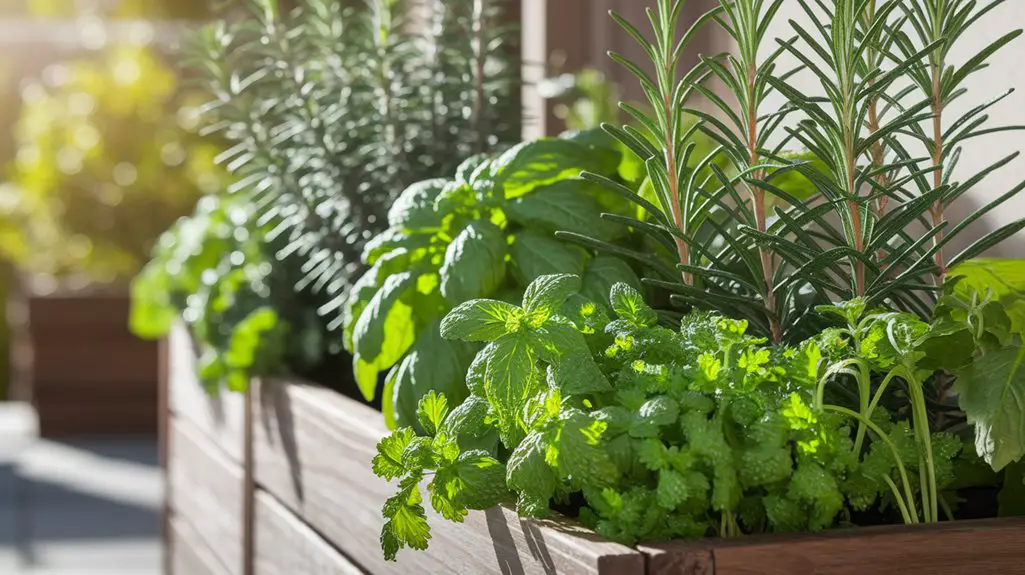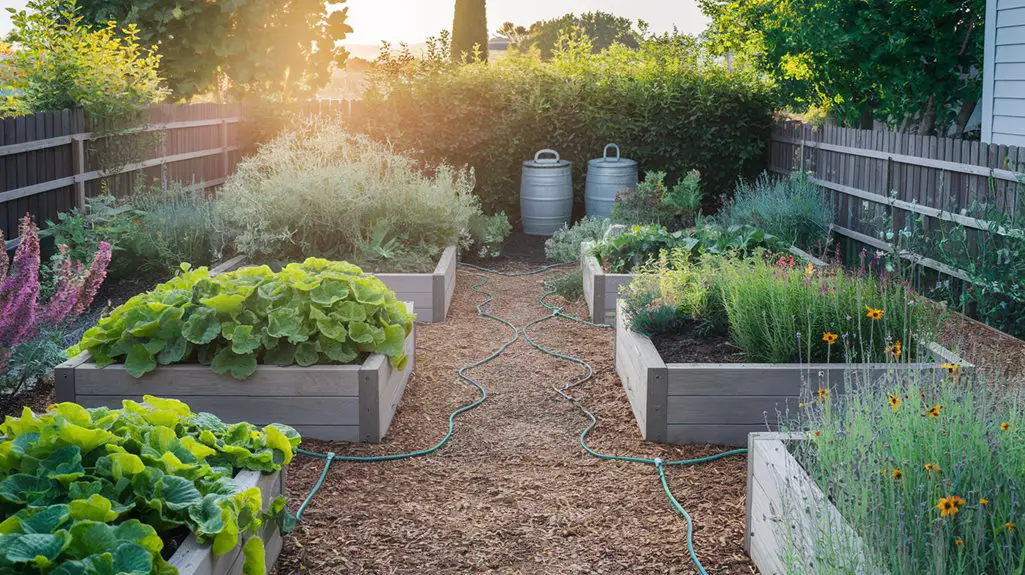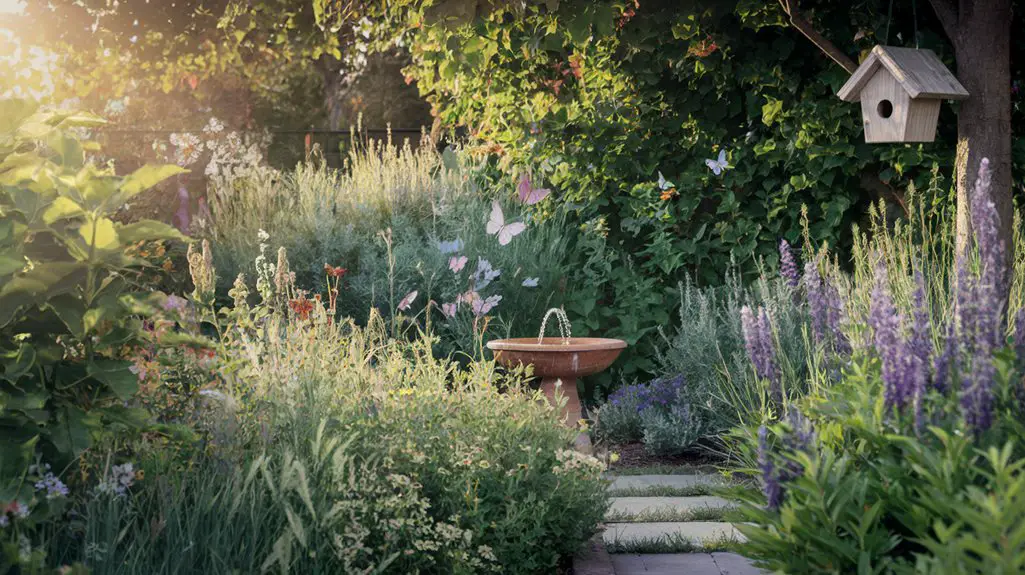Do beginner gardeners really need extensive experience to grow herbs successfully? You'll find that even with minimal gardening skills, certain herb varieties thrive with basic care. Starting with these seven herbs—basil, mint, chives, thyme, parsley, cilantro, and rosemary—provides both immediate satisfaction and practical culinary benefits. Each offers distinct growth patterns and flavor profiles while requiring surprisingly little maintenance. The perfect herb garden awaits in the following selections.
Basil: The Versatile Kitchen Essential
Because of its robust flavor profile and culinary versatility, basil stands as the cornerstone of any beginner's herb garden.
You'll find this annual herb thrives in warm conditions with 6-8 hours of direct sunlight daily. Plant in well-draining soil with a pH between 6.0-7.0 for ideal growth.
Maintain consistent watering—keeping soil moist but never waterlogged—and you'll enjoy continuous harvests throughout summer.
Pinch off flowering stems promptly to extend leaf production. When harvesting, take leaves from the top to encourage bushier growth.
Basil varieties offer diverse cultivation experiences: Genovese delivers classic Italian flavor, Thai basil provides anise notes, and compact Greek basil suits container gardens perfectly.
For preservation, consider freezing in olive oil or drying at 95°F to maintain essential oils and flavor compounds. Additionally, basil is often regarded as an essential herb in backyard gardens for its ease of growth and adaptability to various climates.
Mint: A Hardy Perennial for Any Space

While basil requires careful attention to sunlight and water, mint represents the opposite end of the gardening spectrum. This aggressive perennial thrives in USDA zones 3-11 and will colonize any space you provide—often beyond intended boundaries.
Plant mint in containers to prevent invasive spreading. It tolerates partial shade and adapts to most soil types, though it prefers consistent moisture. For peak oil production, harvest leaves before flowering by cutting stems 1-2 inches above soil level.
Common varieties include Mentha spicata (spearmint), ideal for culinary use, and Mentha piperita (peppermint), which contains higher concentrations of menthol. Both repel aphids, cabbage moths, and rodents when strategically placed throughout your garden. Mint's ability to thrive in various conditions makes it a hardy perennial that is perfect for beginner gardeners.
Use fresh leaves for teas, cocktails, and desserts, or dry them for year-round use.
Rosemary: The Drought-Tolerant Mediterranean Delight

Rosemary (Rosmarinus officinalis) stands as an excellent choice for beginning gardeners seeking a low-maintenance herb with multiple uses. This Mediterranean native thrives in well-drained soil and full sun, requiring minimal watering once established. Its woody stems and needle-like leaves contain aromatic oils that intensify in hot, dry conditions.
- Plant in containers or well-drained garden beds where soil pH ranges from 6.0-7.0
- Water deeply but infrequently, allowing soil to dry completely between irrigations
- Harvest year-round by cutting 4-5 inch stems, avoiding removal of more than one-third of the plant
- Prune after flowering to maintain compact growth and prevent woody, unproductive stems
You'll find rosemary remarkably resilient against most pests and diseases, particularly when provided proper drainage and air circulation. Additionally, incorporating eco-friendly practices can further enhance its growth and sustainability in your garden.
Its drought tolerance makes it ideal for water-conscious gardeners.
Chives: Easy-Growing Alliums for Instant Flavor

Chives (Allium schoenoprasum) represent the perfect entry point for novice herb gardeners seeking immediate culinary gratification. Their slender, hollow leaves emerge early in spring, providing months of harvest with minimal maintenance.
Unlike fussier herbs, chives thrive in average soil with moderate moisture and tolerate partial shade. You'll appreciate their pest-resistant qualities—the natural allium compounds that give chives their oniony flavor also deter common garden insects. Additionally, these herbs can help keep pests away due to their natural repellent properties.
Plant them in containers or borders, allowing 8-12 inches between clumps. For ideal production, divide established plants every 3-4 years in early spring.
Harvest chives by snipping leaves 2 inches above soil level with sharp scissors. Regular cutting encourages fresh growth.
The edible purple blossoms that appear in late spring not only attract pollinators but serve as decorative, flavorful garnishes for summer dishes.
Thyme: A Low-Growing Herb for Sunny Spots

Thyme (Thymus vulgaris) establishes itself as one of the most forgiving herbs for beginners, thriving in conditions that would stress less hardy plants. This Mediterranean perennial requires minimal attention once established in well-drained soil and full sunlight. Container gardening is an ideal method for growing thyme, allowing for easy movement to capture optimal sunlight exposure.
You'll find its woody stems and tiny aromatic leaves perfect for container gardening, rock gardens, or as edging plants.
- Plant in soil with pH 6.0-8.0, adding limestone to acidic soils for ideal growth
- Water sparingly after establishment—thyme's drought tolerance makes it perfect for gardeners who forget to irrigate
- Harvest by cutting stems back by one-third, encouraging bushier growth and preventing woodiness
- Overwinter outdoors in zones 5-9, applying light mulch in colder regions to protect root systems
Trim thyme regularly to maintain its compact habit and promote fresh, tender growth throughout the growing season.
Parsley: The Biennial Powerhouse for Your Garden
Unlike thyme's woody permanence, Parsley (Petroselinum crispum) offers a different experience as a biennial herb that completes its lifecycle in two growing seasons.
During its first year, it produces the familiar rosette of curly or flat-leaf foliage prized in cuisine. In year two, it bolts, flowers, sets seed, then dies.
Sow seeds directly outdoors after the last frost, or start indoors 3-4 weeks earlier. Seeds germinate slowly (2-3 weeks), so soak them overnight to hasten sprouting.
Choose a location with morning sun and afternoon shade in zones 5-9, providing consistent moisture and well-draining soil with pH 6.0-7.0.
Harvest outer stems first by cutting at the base, allowing inner growth to continue developing. Regular harvesting promotes bushier growth and extends productivity. Additionally, Parsley attracts various pollinators like bees, making it a beneficial addition to your herb garden.
Cilantro: Quick-Growing Greens for Global Cuisine
While parsley takes its time establishing in your garden, Cilantro (Coriandrum sativum) delivers remarkable versatility with its swift growth cycle, typically reaching harvest readiness in just 3-4 weeks after germination.
You'll succeed with cilantro by understanding its preference for cool weather—plant in early spring or fall when temperatures hover between 50-85°F. This herb bolts quickly in summer heat, so succession planting every 2-3 weeks guarantees continuous harvests.
Cilantro thrives in well-draining soil with moderate fertility and consistent moisture. Regular vegetable garden maintenance is key to ensuring a healthy crop.
- Plant seeds ¼ inch deep in rows 12 inches apart
- Harvest outer leaves first to promote continued growth
- Collect seeds (coriander) after flowering for dual-purpose value
- Grow in partial shade during warmer months to delay bolting
Conclusion
With these seven herbs, you'll establish a productive garden within weeks. Plant basil and cilantro after the last frost, while perennials like rosemary and thyme will provide years of harvests. One client's 4'×6' raised bed yielded sufficient herbs for daily cooking and seasonal preservation. Position taller herbs northward to prevent shading smaller varieties. Water at soil level to prevent fungal issues, and harvest regularly to encourage robust growth.




